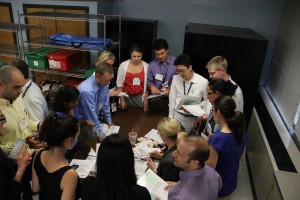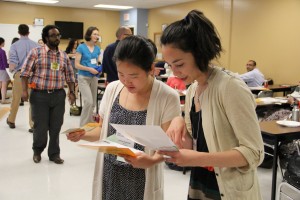Pediatric Residents get a Reality Check during Poverty Simulation
Goal: Keep food on your table, keep the lights on in your house, keep your kids in school, and get to work.
Sounds easy enough, right? Does it still sound easy when your family’s budget is consistently $250 short of what you critically need?
This was the challenge posed to 35 new pediatric residents of the Boston Combined Residency Program at BMC and Children’s Hospital Boston in a poverty simulation designed to spread awareness about the struggles many patients face. During four, 15-minute intervals, the residents were asked to go about a typical month in the life of a family living below the poverty line—some as children, some as parents, some as grandparents.

They were thrown into situations that the 46.2 million Americans face everyday.* One in five children live below the poverty line in the U.S. and children living in Mattapan, Dorchester and Roxbury, three communities in the closest proximity to BMC, have a combined poverty rate of 42 percent.
“If I were to tell you that 20 percent of your patients had a chronic disease, you would want to know more about it, right?” said Megan Sandel, MD, Pediatrics.
The residents were organized into various family situations simulating the very real situations of some of BMC’s patients. Walking in the shoes of these families, the residents had to make hard decisions quickly—choosing between picking up their paychecks or picking up their child at school, paying for food or paying for their rent.
“People have described poverty as choosing the lesser of two evils. You’re faced with either making a bad choice or a really bad choice,” said Sandel.
With pay checks that just did not cover their needs, and weeks that went by too quickly to work, take care of their children, shop for groceries and handle bills, the residents’ attitudes changed. At first, they were eager to figure out a way to make what they had work. Some tried to work extra jobs, longer hours, or find a way to get more government benefits the first week, only to realize that the paperwork and the unhelpful staff meant this process took so long it only hurt their situation.
“You learned quickly that you couldn’t just outsmart your way out of a problem; you just didn’t have enough resources,” said one attendee looking back on it.
By the end, many had resolved to just go to work, pick up their children, and pawn their possessions for whatever money they could get.

“I think coming to the realization that staying afloat wasn’t even possible and had to focus on minimizing losses as opposed to even attempting to stay above water was quickly learned,” said one attendee.
Though the residents were lucky enough to be able to end the simulation and return to their lives, they were made aware that many of their patients could not walk away from these situations as easily. They will be interacting with patients over the next few years who will be just as frustrated as they were during the simulation because of the inability to make ends meet, patients who will have more pressing issues than their health sometimes.
“These are real life experiences you are going to experience throughout your residency here,” Sandel said.
*According to U.S. Census Bureau statistics in 2011.Submitted by Amy Gorel.